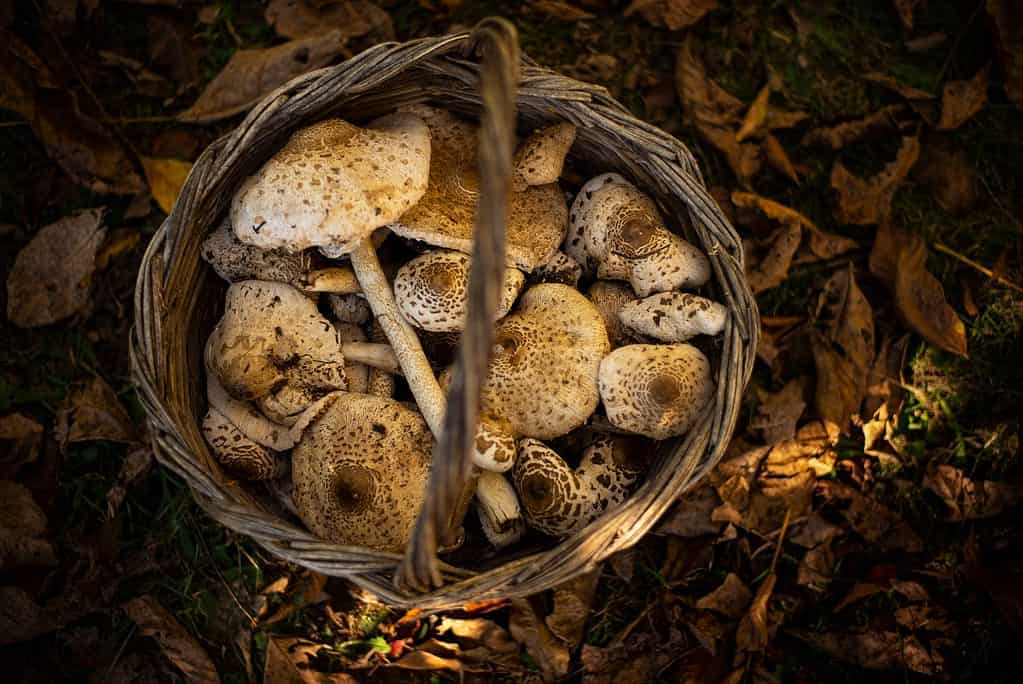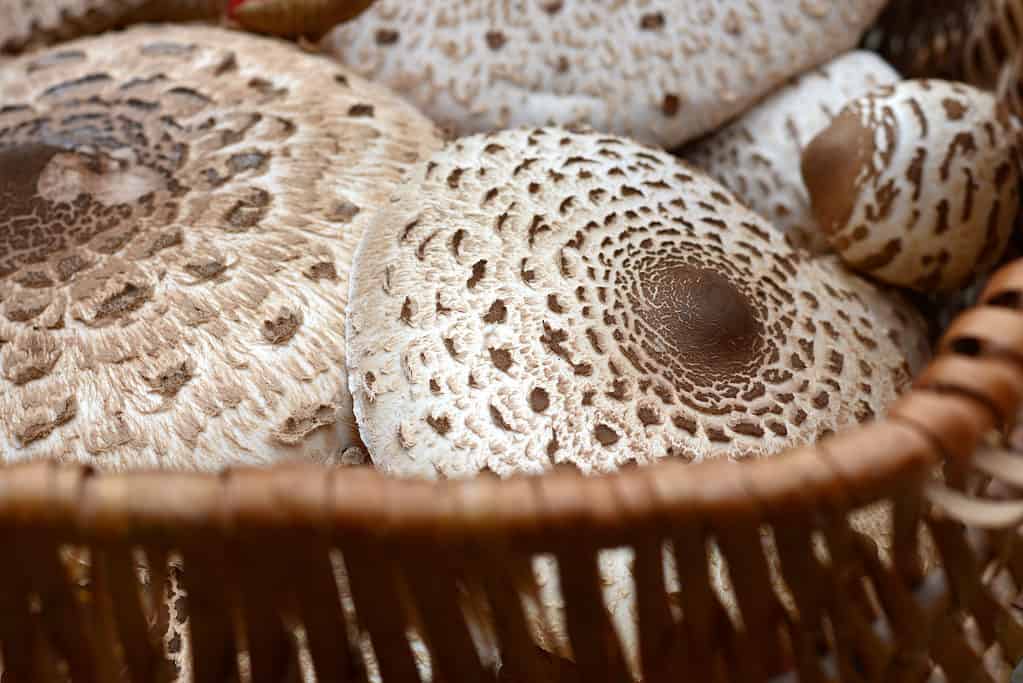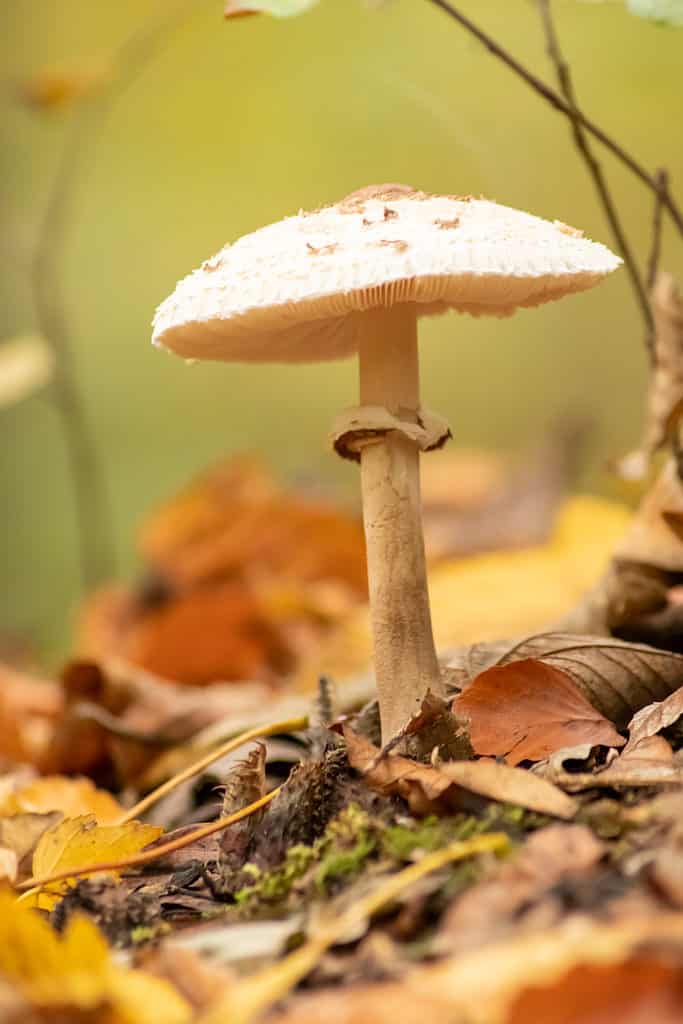There are literally hundreds of mushrooms species around the world and most of us aren’t familiar with more than a handful of them. The parasol mushroom is one that may well have never made it to your radar until recently, but this edible mushroom is a lovely addition to a variety of meals and dishes, if prepared properly.
Let’s take a ganger at this unique fungi in all its pink and “spiked” glory and see what it’s all about.

Parasol mushrooms may be found in forest clearings.
©Bonchev Photography/Shutterstock.com
Parasol Mushrooms Classification
Scientifically known as Macrolepiota procera, parasol mushrooms are a basidiomycete fungus that is fairly common in well-drained soils. The fungi may be found as solitary growers or as fairy rings in pastures and woodlands. The fungi was first classed as Agaricus procerus by Giovanni Antonio Scopoli, but was later reclassed by Rolf Singer into the Macrolepiota genus where it remains.
The mushroom is part of the Agariceae family and is known by several other names, including parasol mushroom (named for its parasol cap shape), Snake’s Hat mushroom, and Snake’s Sponge mushroom.
Where Do Parasol Mushrooms Grow?

Before maturing, the mushrooms have egg-shaped caps.
©Marc Venema/Shutterstock.com
Occasionally, you’ll find parasols growing in gardens and allotments, but more often, these unique mushrooms pop up in woodland clearings, pastures, grassy areas, and in stable sand dunes. The mushroom is most frequently found growing in the wild in southern Britain and Ireland, though it may be found in northern England and Scotland as well, save in sheltered coastal areas. The mushroom may also be found throughout the United States and mainland Europe. They grow from July to November in many regions.
Are Parasol Mushrooms Safe to Eat?
They’re not as commonly known, but parasol mushrooms are indeed edible fungi. Some folks don’t feel great afterward, but they are not inherently toxic. Most folks recommend trying them in small batches and seeing how they sit before digging in for deeper dishes.
Flavor Profile for Parasol Mushrooms
Parasol mushrooms have a rich umami flavor and tenderness when they are cooked. They’re described by some as having a nutty, sweet aroma a bit like maple syrup. However, when the mushrooms are dried, they have a much more pungent aroma.
How Are Parasol Mushrooms Used?

These mushrooms are truly beautiful.
©Dar1930/Shutterstock.com
These choice, edible mushrooms are popular throughout Europe and are gaining popularity in the United States. The fungi are large in size, frequently available, and incredibly versatile in culinary uses. Technically, the mushroom is edible raw, but its look alike (Chlorphyllym) is toxic in the raw. It’s best to cook them to be safe.
Parasol mushrooms are particularly popular sauteed in butted and served up as a side dish, or may be prepared similarly to a meat cutlet as a Vegan-friendly substitute for the meat. The mushrooms may be battered and fried, stuffed with ground pork and oregano and garlic (a Slovak dish), stuffed with seasoned minced beef and baked like stuffed peppers (Italian and Austrian recipes), or added to soups and stews. They’re often chopped up and added to omelets, sauces, and stir fries, may be baked into savory pies, stuffed vegetables, or fried to make tempura.
History of the Parasol Mushroom
These unique mushrooms were first described in writing in 1772, by Italian naturalist, Giovanni Antonio Scopoli (or Joannes Antonius Scopoli). Most gilled mushrooms are the Agricus genus where he placed it, though most of those have been relocated to more accurate families since. In 1948, Rolf Singer, a German mycologist, moved the mushroom to its present genus. One of the big splits in this placement was moving this edible mushroom into a family not with the toxic Chlorphyllum, which is toxic and may be deadly, including the Shaggy Parasol mushroom that looks rather like this edible fungus.
How Much Do Parasol Mushrooms Cost?
Parasol mushrooms are specialty produce, so they tend to run in higher price ranges. Typically, they are one of the most expensive options on the market, often running at around $15 a pound.
Where Can I Find Parasol Mushrooms in the Wild?

The mushrooms when harvested young will look a bit like eggs on birch branches.
©LeManilo/Shutterstock.com
DISCLAIMER: Always check with a mycologist to confirm your finds and before ingesting.
If you’re working with a mycologist (mushroom expert), it may be safe to go hunting for some parasol mushrooms to bring home. You’ll find them along roadsides, in forest clearings, in pasturelands and meadows, and even on grassy seaside cliffs. However, there are some similar-looking mushrooms which are extremely toxic, so it’s incredibly important you have an expert examine any wild mushrooms before you eat them.
Where to Buy Pre-Grown Parasol Mushrooms
You may find parasol mushrooms available for purchase online and in some specialty and health food stores.
Where to Buy Parasol Mushrooms to Grow
If you’re interested in growing some parasol mushrooms, be sure to check online sites and nurseries that specialize in mushrooms, and be sure that the company has a solid reputation to avoid getting false parasols that could be toxic.
How to Identify Parasol Mushrooms

These mushrooms are distinctive looking.
©milart/Shutterstock.com
Parasol mushrooms are medium to large mushrooms with caps that may grow as large as 15 inches in diameter. They may reach that same height of 15 inches. When these mushrooms are young, they have beige or pale brown caps that are rounded and egg-shaped. They have a small dark brown nob on the top. As they age, they open out into a parasol shape and flatten out, with the brown nob breaking down into flaky scales.
Under the cap, the mushrooms have soft, spongy flesh and white gilled, an ivory stem that’s fibrous and covered in snakeskin-like patterns of brown flakes. This is how it has earned its nickname of Snake’s Hat mushroom. When sliced, the flesh of the mushroom may turn pale pink.
How to Grow Parasol Mushrooms
You may be able to grow parasol mushrooms at home, but most folks find it difficult to do so. If you’re going to invest the time and effort, be sure to use a mixture of compost and straw layer substrate. The mushroom likes cooler temperatures and thrives in 54 to 68 degrees Fahrenheit. Being fungi, they do best when cultivated in cool, dark locations like a basement.
To grow them, spread out 2 to 3 inches of compost in a large compact container. Add a thick later of wheat straw that has been soaked in hot water. Inject several small amounts of your parasol mushroom mycelium into the straw and compost mix, then cover it all with some plastic sheets that have small holes cut into it. Spray water through the holes into the substrate once a day to keep the soil moist.
The mushrooms, if you’re successful, will start to colonize and produce fruit in 5 weeks to 2 months.
Parasol Mushroom Trivia

Parasol mushrooms often grow in isolation.
©sunarki/Shutterstock.com
These mushrooms are a unique looking, fun, large fungi that deservedly have garnered attention in more recent years as a tasty addition to the kitchen. This unique fungus gets its various nicknames from its appearance – first as a parasol from the cap, second as a “snake’s hat” from the unique pattern and coloration on the stems. These mushrooms have been frequently represented in the artwork of Europe (you’ve likely seen some paintings and not thought twice about the type of mushroom!). It was also featured on a stamp from Azerbaijan in 1995 and in Cambodia in 1989.
In Scotland, parasol mushrooms feature prominently in legend. The fairy rings don’t exactly hurt this folklore stature! Supposedly, fairies love to sit atop the parasol mushrooms and host their picnics on them. In Wales, these beauties have their own lore: the fairies use them as umbrellas. The fungus also grows in the Himalayas and are often gathered for food by cattle herders.
Up Next:
- Beech Mushrooms: A Complete Guide
- Shiitake Mushrooms: A Complete Guide
- Discover the Largest Mushroom Ever Grown
- Perennial Vs. Annual Plants
The photo featured at the top of this post is © sunarki/Shutterstock.com
The information presented on or through the Website is made available solely for general informational purposes. We do not warrant the accuracy, completeness, or usefulness of this information. Any reliance you place on such information is strictly at your own risk. We disclaim all liability and responsibility arising from any reliance placed on such materials by you or any other visitor to the Website, or by anyone who may be informed of any of its contents. None of the statements or claims on the Website should be taken as medical advice, health advice, or as confirmation that a plant, fungus, or other item is safe for consumption or will provide any health benefits. Anyone considering the health benefits of particular plant, fungus, or other item should first consult with a doctor or other medical professional. The statements made within this Website have not been evaluated by the Food and Drug Administration. These statements are not intended to diagnose, treat, cure or prevent any disease.
Thank you for reading! Have some feedback for us? Contact the AZ Animals editorial team.







